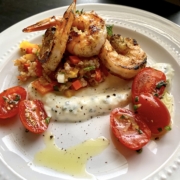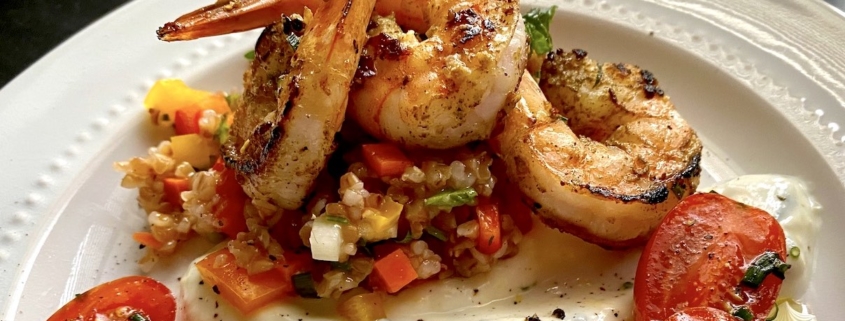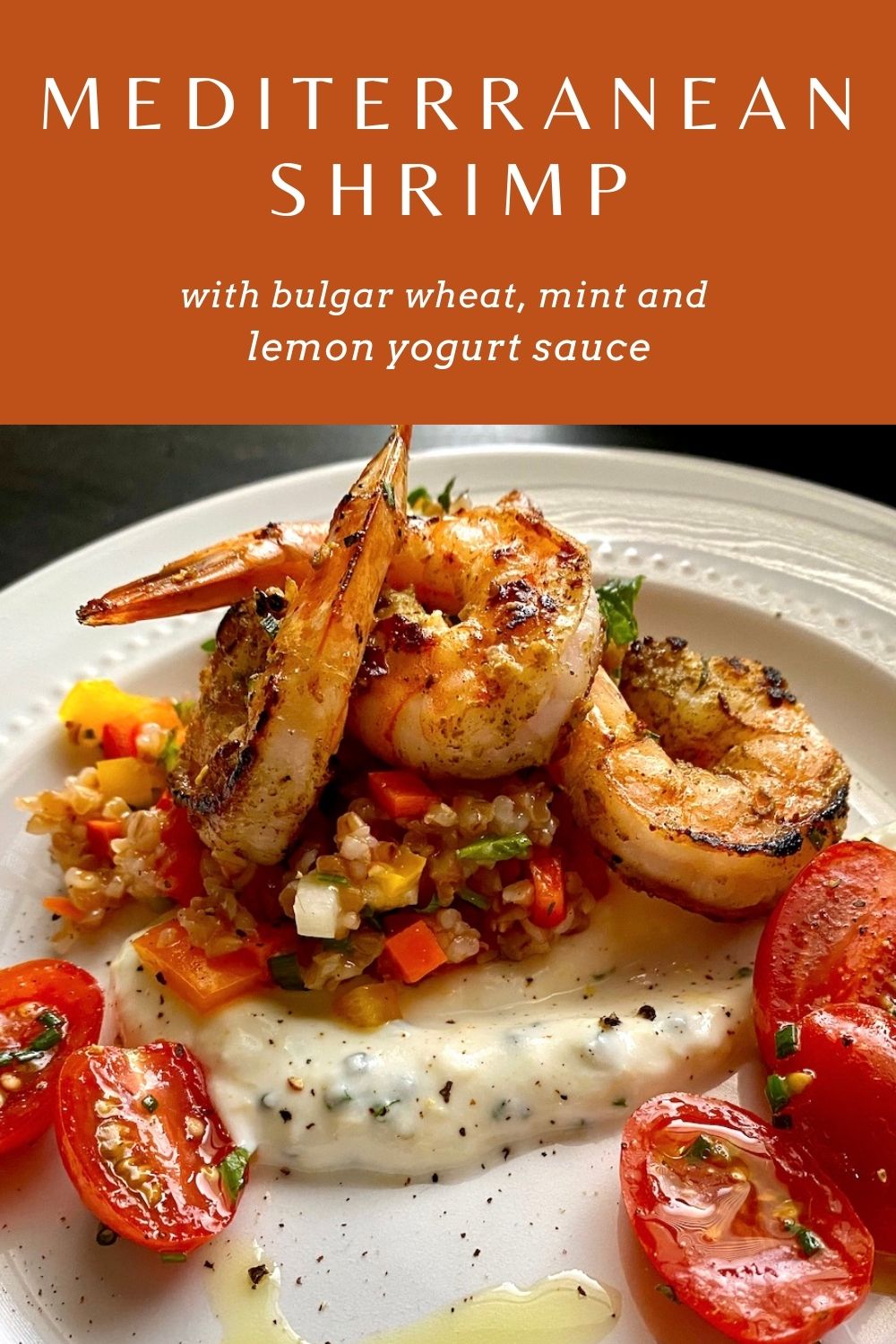Mediterranean Shrimp with Bulgur Wheat, Mint and Lemon Yogurt
When it comes to seafood, shrimp is one of the most popular choices. But I’m putting a new spin on the shellfish with this Mediterranean shrimp recipe. A total departure from peel-and-eat, this shrimp dish features Middle Eastern spice and an unusual grain. I think you’ll love how this sensual seafood recipe captivates all of the senses in one bite.
There are the vibrant colors and crisp crunch of fresh vegetables, exotic aromas from citrus, spices and herbs, and the silky cool lemon yogurt dressing with the warm savory shrimp that slip together across your tongue in a dance of different temperatures.
A shrimp dish with exotic flavors
The combination of ingredients and flavors whisk you away to a far-off spice market with every bite. Yet the ingredients in this shrimp dish are simple enough to find in your local grocery store. And you may not need to look further than your own garden to find the fresh mint that gives this healthy shrimp dish its aromatic freshness. Of course, shrimp are aphrodisiac as well, which makes us want this recipe even more!
I do want to add that while the ingredients are easy to find, some may be unfamiliar. So before we dive into this Middle Eastern seafood dish, let’s take a closer look at some of the more exotic ingredients.
What is za’atar?
This recipe calls for seasoning the shrimp with za’atar. Za’atar is a seasoning blend that originated in the Middle East. It’s grown in global popularity over the past decade or so. The actual blend may vary from chef to chef, but the main ingredients are dried oregano, Mediterranean thyme, marjoram, sumac, toasted sesame seeds and salt. Its use dates back to ancient Egypt.
Where can I buy za’atar?
Because of it’s recent popularity, za’atar has become a fairly easy spice blend to buy. You can find it in the spice section of many grocery stores. Even Trader Joe’s has their own za’atar blend. Or you can just order it online for home delivery.
About bulgur wheat
Even if you aren’t familiar with bulgur, you may have had it before in tabbouleh salad or other Middle Eastern or Mediterranean dishes. Bulgur is an ancient grain originating in the Mediterranean. It has been around for several thousand years. It is cracked wheat, usually made from durum, that has been parboiled and dried before storing. That makes it easy and fast to cook.
How to cook bulgar wheat
Bulgur is a very easy ingredient to work with, even if you’ve never used it before. All you need to do is put it in a pot with twice as much liquid and a bit of salt, bring it to a boil, cover and simmer for about 15-20 minutes. Fluff it with a fork and serve it like rice, or use it in salads like the one in this healthy shrimp recipe.
Want to try more bulgur recipes? Check out this Minted Bulghar Salad with Pine Nuts and Feta.
How to shop for shrimp
When you shop for shrimp you have lots of choices. Here are a few things to pay attention to when selecting shrimp for this recipe:
- If the sign at the fish counter says “previously frozen” – buy the frozen shrimp and thaw them yourself.
- Read the ingredients on the package… if there’s anything other than “shrimp” listed, move on!
- Buy your shrimp raw – cook them yourself or risk rubbery hard shrimp.
- Go ahead and buy them already peeled and deveined (we’re not masochists here!)
- If you do peel them yourself, save the shells and use them to reinforce cooking stock – shrimp shells make excellent stock.
- Standard sizing: look for numbers not words. Large doesn’t tell you anything but the numbers 31/35 tell you that there are between 31-35 of those shrimp in each pound. This recipe calls for 16/20s (extra jumbo) but you can use 26/30s or 31/35s if you like.
- The smaller the number the bigger the shrimp. The largest shrimp you’re likely to find in the market are U-10. That means under 10 shrimp per pound – those are some big shrimp!
How to make a garnish of salted tomatoes
This colorful dish is garnished with cherry or grape tomato halves. But instead of simply cutting them and placing them on the plate, you’ll notice that we recommend salting them lightly and letting them sit a few minutes that way before using them. Why is that?
This is a technique called disgorging. It means to draw out – and that’s exactly what salt does. By lightly salting the tomatoes in advance, their own juices are drawn out and contribute to the flavor and texture they bring to the dish. Salt is also a flavor enhancer, so a little bit just makes the tomatoes taste sweeter and tomato-y.
This technique is also commonly used with cucumbers in Mediterranean dishes. And it is incredibly tasty! Once you’ve mastered it, it’s a garnish you’re sure to use again and again.
When to serve this Mediterranean seafood recipe
This healthy shrimp recipe can be served as an elegant plated appetizer for a romantic evening at home along with one of our favorite pairings – bubbles, of course! Or you can get more casual and serve it picnic-style while enjoying a romantic sunset and this aphrodisiac thyme and honey gin fizz.
Want more shrimp recipes? Don’t miss Blackened Shrimp with Pomegranate and Kumquat Salad

Mediterranean Shrimp with Bulgur Wheat, Bell Peppers, Mint and Lemon Yogurt
Ingredients
for the bulgur salad
- 1/2 cup bulgur
- 1 cup stock or water
- 1/2 tsp kosher salt
- 1/4 cup red bell pepper small dice
- 1/4 cup green bell pepper small dice
- 1/4 cup yellow bell pepper small dice
- 1 stalk celery small dice
- 2 scallions finely chopped
- 1/2 tsp kosher salt
- 1/4 cup Italian parsley roughly chopped
- 1/8 cup mint roughly chopped
- 2 tbsp olive oil extra virgin
- 2 tbsp lemon juice
for the lemon yogurt sauce
- 1/2 cup low-fat Greek yogurt
- zest of 1 lemon
- 1 tbsp chives finely chopped
- salt and pepper to taste
for the shrimp
- 12 peeled and deveined shrimp size 16/20
- 1/2 tsp kosher salt
- 1 tbsp olive oil
- 1 tbsp za'atar seasoning
for the garnish
- 12 cherry tomatoes cut in half
- 1/4 tsp kosher salt
- extra virgin olive oil for drizzling
Instructions
for the bulgur salad
- bring bulgur, salt, and stock or water to boil in a saucepan with a lid.
- Cover and reduce heat to low. Simmer 20 minutes or until all liquid is absorbed.
- Remove from heat. Fluff with a fork and allow to cool slighly while preparing the vegetables.
- In a medium mixing bowl, combine the diced peppers, celery, and scallions. Season with salt, lemon juice and olive oil.
- Fold the still-warm bulgur into the vegetables. Add the parsley and mint. Season to taste.
- This may be made up to 2 days in advance. Wait to add the fresh herbs until the day you are serving.
- This yields more than you need for this plating. You may increase the portion or store the remainder for up to 2-3 days in the refrigerator.
for the lemon yogurt sauce
- Mix the lemon zest and chives into the yogurt. Season with salt and pepper to taste.
- This may be made up to 2 days in advance and stored in the refrigerator.
for the tomatoes
- Slice the tomatoes in half the long way. Season with salt and allow to rest at least 5-10 minutes before serving.
- Can be prepared up to 2 hours before serving. Can be refrigerated.
for the shrimp
- Toss shrimp the raw shrimp with salt and seasoning. Allow to marinate at room temperature for 15-30 minutes.
- Heat oil in a non-stick skillet over medium-high heat until shimmering but not smoking.
- Add the shrimp to the skillet in a single layer (work in batches if you must)
- Cook approximately 1-2 minutes per side until the shrimps turn red and curl slightly, but do not overcook.
- Assemble the dishes immediately.
to serve
- Place 1 tbsp lemon yogurt sauce on the bottom of each of 4 appetizer plates. Pull the back of the spoon through the dollop to create a swoosh effect.
- Place 1/4 cup of the bulgur salad beside the yogurt sauce on each plate.
- Place 3 shrimp on top of the bulgur.
- Garnish with 5-6 tomato halves per plate and a drizzle of extra virgin olive oil.
- Easy Oven Roasted Turkey Breast Roll Recipe with Wild Mushrooms and Kale - December 1, 2023
- A Sexy Hot Sorrel Drink Recipe with Caribbean Rum - November 30, 2023
- Charcuterie Board for Two: how to build a date night charcuterie board - November 10, 2023
Did you know that eating the right foods can be the key to boost your sex life?
Subscribe to the Eat Something Sexy mailing list and get our exclusive list of Six Great Sex-Boosting Snack Foods for FREE!







Leave a Reply
Want to join the discussion?Feel free to contribute!